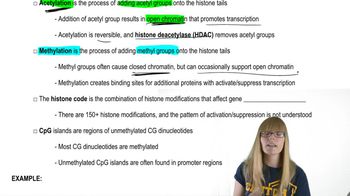Table of contents
- 1. Introduction to Genetics51m
- 2. Mendel's Laws of Inheritance3h 37m
- 3. Extensions to Mendelian Inheritance2h 41m
- 4. Genetic Mapping and Linkage2h 28m
- 5. Genetics of Bacteria and Viruses1h 21m
- 6. Chromosomal Variation1h 48m
- 7. DNA and Chromosome Structure56m
- 8. DNA Replication1h 10m
- 9. Mitosis and Meiosis1h 34m
- 10. Transcription1h 0m
- 11. Translation58m
- 12. Gene Regulation in Prokaryotes1h 19m
- 13. Gene Regulation in Eukaryotes44m
- 14. Genetic Control of Development44m
- 15. Genomes and Genomics1h 50m
- 16. Transposable Elements47m
- 17. Mutation, Repair, and Recombination1h 6m
- 18. Molecular Genetic Tools19m
- 19. Cancer Genetics29m
- 20. Quantitative Genetics1h 26m
- 21. Population Genetics50m
- 22. Evolutionary Genetics29m
13. Gene Regulation in Eukaryotes
Epigenetics, Chromatin Modifications, and Regulation
Problem 7b
Textbook Question
Provide a brief description of two different types of histone modification and how they impact transcription.
 Verified step by step guidance
Verified step by step guidance1
Identify the two types of histone modifications: acetylation and methylation.
Explain histone acetylation: This involves the addition of an acetyl group (CH3CO) to the lysine residues in histone proteins, typically by histone acetyltransferases (HATs).
Discuss the impact of acetylation on transcription: Acetylation neutralizes the positive charge on histones, reducing their affinity for negatively charged DNA, leading to a more relaxed chromatin structure and increased transcriptional activity.
Explain histone methylation: This involves the addition of one, two, or three methyl groups to lysine or arginine residues on histones, typically by histone methyltransferases.
Discuss the impact of methylation on transcription: Methylation can either activate or repress transcription depending on the specific amino acid residue that is methylated and the number of methyl groups added. For example, trimethylation of histone H3 at lysine 4 (H3K4me3) is associated with active transcription, while trimethylation at lysine 27 (H3K27me3) is associated with transcriptional repression.
Recommended similar problem, with video answer:
 Verified Solution
Verified SolutionThis video solution was recommended by our tutors as helpful for the problem above
Video duration:
28sPlay a video:
Was this helpful?
Key Concepts
Here are the essential concepts you must grasp in order to answer the question correctly.
Histone Acetylation
Histone acetylation involves the addition of acetyl groups to lysine residues on histone proteins, which reduces the positive charge on histones. This modification leads to a more relaxed chromatin structure, facilitating access for transcription factors and RNA polymerase. As a result, genes associated with acetylated histones are typically expressed at higher levels.
Recommended video:
Guided course

Histone Protein Modifications
Histone Methylation
Histone methylation refers to the addition of methyl groups to specific amino acids on histones, which can either activate or repress transcription depending on the context and the specific residues modified. For instance, methylation of lysine 4 on histone H3 (H3K4me) is associated with active transcription, while methylation of lysine 27 (H3K27me) is linked to gene silencing. This dual role makes methylation a critical regulator of gene expression.
Recommended video:
Guided course

Histone Protein Modifications
Transcription Regulation
Transcription regulation is the process by which cells control the expression of genes, ensuring that the right genes are expressed at the right times. Histone modifications play a crucial role in this regulation by altering chromatin structure and accessibility. By influencing the binding of transcription factors and the transcriptional machinery, these modifications can either promote or inhibit the transcription of specific genes.
Recommended video:
Guided course

Eukaryotic Transcription





